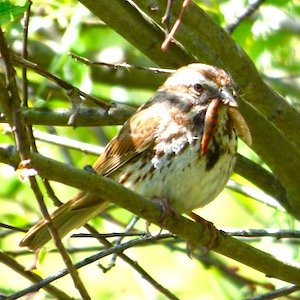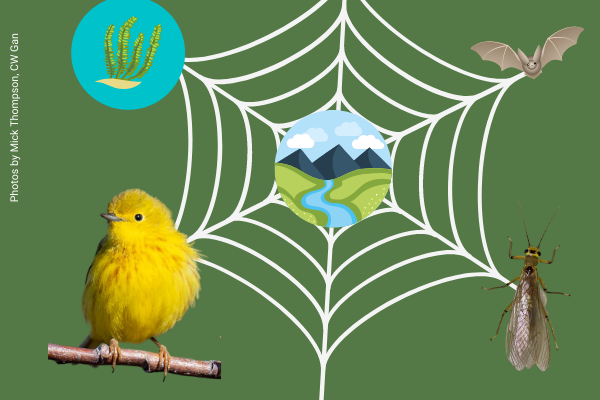When is a Yellow Warbler like a rainbow trout? Wings vs. fins, warm-blooded vs. cold-blooded, they seem radically different. But when you are thinking in terms of riparian and river ecosystems, birds may be very similar to fish. And it turns out bats are an awful lot like fish as well. How so? It's all about what they eat.
IBP biologist Lynn Schofield recently lent her bird expertise to a study of food chains led by Yosemite National Park and University of California scientist Breeanne Jackson. The study looked at riparian food chains on two rivers in Yosemite the Tuolumne and the Merced River. Their results were recently published in the journal Ecosphere.

IBP biologist Lynn Scohfield at one of the study's field sites.
The researchers used stable isotope analysis of carbon and nitrogen to determine the trophic position (aka position in the food chain) and diet of birds and bats. Both carbon and nitrogen atoms, which are abundant in plant and animal tissues, come in different flavors or isotopes depending on how many neutrons are in the nucleus. For instance, carbon 12 (12C) has 6 neutrons while carbon 13 (13C) has 7 neutrons, while nitrogen commonly occurs in 15N and 14N isotopes.
Primary producers, like plants and algae, include different ratios of 12C and 13C, as well as 15N and 14N isotopes in their tissues depending on whether they are aquatic or terrestrial. This isotope ratio is preserved even when the plant or algae is consumed by an animal, and even when that animal is consumed by another animal, and the atoms are incorporated into the second animal’s tissues. So the isotope ratios in the tissues of a predator like a warbler can tell you whether it fed primarily on terrestrial insects that consume mostly terrestrial plants (i.e. a grasshopper), or aquatic insects that eat aquatic algae (i.e. a mayfly).
To analyze the ratios of carbon and nitrogen isotopes in a bird, you need a small blood or feather sample. Jackson is an expert in food webs and aquatic ecosystems, but had mostly worked with invertebrates like spiders. So she called in Schofield to plan and implement data collection for the avian portion of the project. Schofield used target mist-netting to capture the focal bird species in the study areas and safely collect samples before releasing the birds unharmed.

A Song Sparrow brings an aquatic insect, most likely an adult stone fly, back to its nest. Photo by Lynn Schofield.
The researchers found that birds (and bats) depended more on aquatic sources of food than you might think. "The rivers were more influential to birds and bats than I would have expected with over half of their diet coming from aquatic sources," says Schofield. "It's strange to think from the perspective of the food web, the birds and bats we studied are essentially fish."
We might expect that aerial insectivores, like Tree Swallows, or species like the American Dipper, consume primarily aquatic insects, with the swallows eating the flying forms and the dipper eating the larval forms. But the study found that even more omnivorous birds like the Black-headed Grosbeak ate large amounts of aquatic insects–over 60% of their diet. But this is less surprising to Schofield: "When a resource is as abundant as emergent aquatic insects it makes sense that many species are going to make use of that," she says.
The study also provided evidence that Black-headed Grosbeaks are quite adaptable. "Grosbeaks did change their position in the food chain between the two years (one wet, one dry) of the study meaning that they changed their primary food sources between years. This suggests grosbeaks have the flexibility to change their diet when needed and take advantage of opportunities when they arise," says Schofield.
Schofield notes that we often think about aquatic ecosystems and terrestrial ecosystems separately:
Food chains on land and in rivers are often treated as if they are separate processes operating in parallel above and below the water. In natural resources, fisheries management and wildlife management are treated as entirely different fields of study. However, aquatic and terrestrial ecosystems affect one another and energy flows between them. The nutrients produced in a river ecosystem system aren't locked into that stream. Insects such as mayflies create a bridge between land and water by taking in the energy produced by algae while they are juveniles and leaving the water when they become adults. Birds and bats eat the insects emerging from the water and can take their energy and nutrients far away from the stream. At the same time, leaves and plant material wash into streams, providing nutrient sources that started on land to aquatic species.
This study demonstrates that the reach of aquatic ecosystems is even greater than we might assume. Consider the Black-headed Grosbeak. In Yosemite these birds nest in trees and taller shrubs at the boundary between the riparian area and the forest where predators like the Northern Goshawk hunt. When the grosbeaks are feeding heavily on aquatic insects and one gets nabbed by a goshawk, those river-derived nutrients and their atoms are passed directly to the goshawk who takes them further into the forest.
As they say, everything is connected. "Consider migratory birds like a Yellow Warbler," says Schofield, "they take the nutrients produced in a river in Yosemite and bring them to ecosystems in Mexico and Central America. It's fun to think about."

Poopenaut Valley in Yosemite National Park, one of the sites where birds were sampled. Photo by Tom Hilton.






